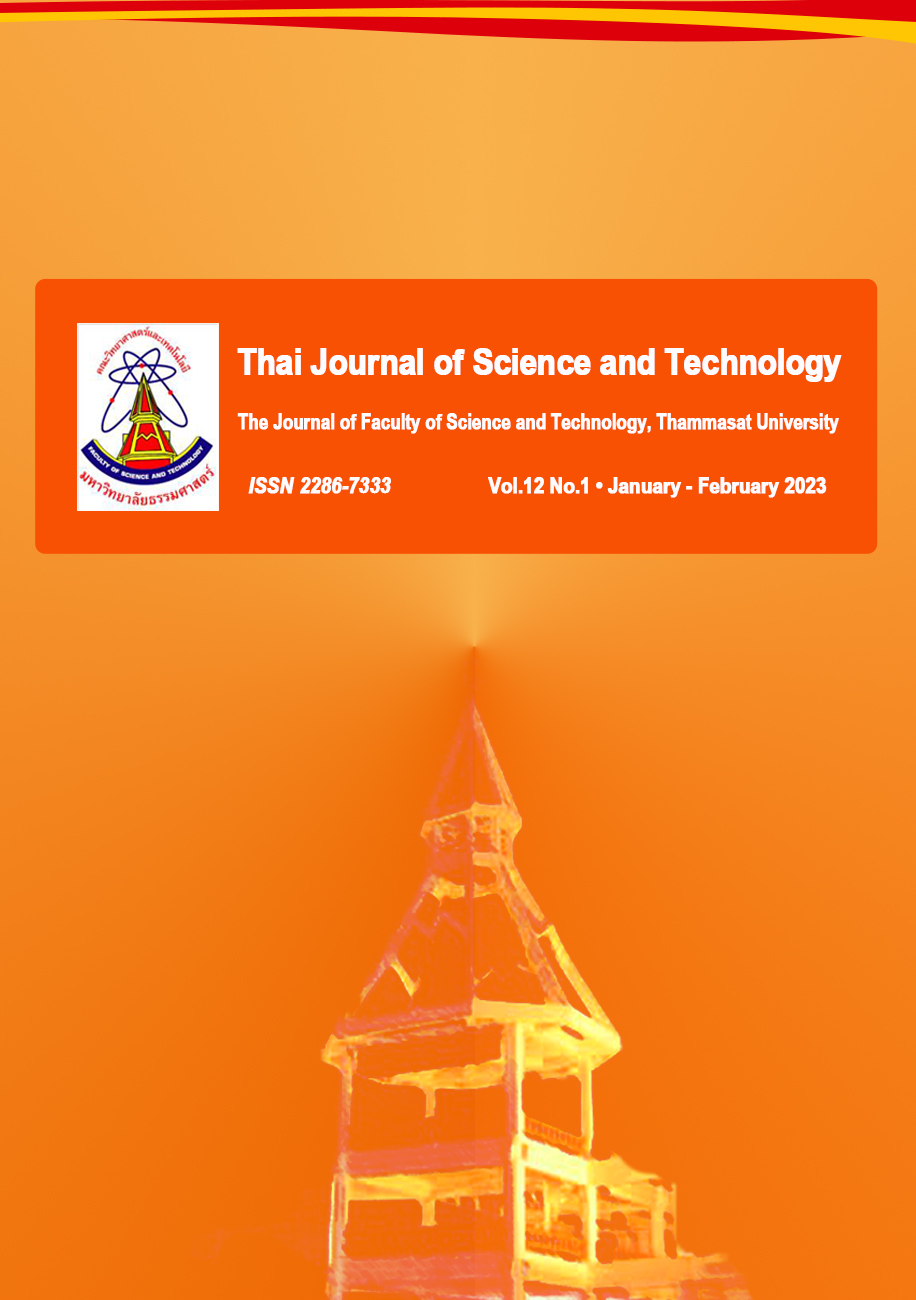Effect of Silicon on Growth and Productivity of Sesamum indicum L. (Ubon Ratchathani 3) under Salinity Stress
Main Article Content
Abstract
The aim of this study was to research the effect of silicon on growth and yield of black sesame (Ubon Ratchathani 3) under salinity conditions. The experimental design was 4x4 Factorial in completely randomized design (CRD) with 5 replications. Factor A consisted of 4 levels of the concentration of sodium chloride (NaCl) (0, 20, 40 and 60 mmol/L) and factor B included 4 levels of silicon in the form of silicic acid (Si(OH)4) (0, 30, 60 and 90 kg/rai). The results found that leaf width showed the most effective performance in sodium chloride 0 mmol/l with silicon 0 kg/rai. Height, leaf length, stem dry weight, pods dry weight, leaf dry weight showed the most effective performance in sodium chloride 0 mmol/l with silicon 90 kg/rai. Number of leaf showed the most effective performance in sodium chloride 0 mmol/l with silicon 60 kg/rai. Root length, number of pods, yield per plant, yield per rai, 1000-weight showed the most effective performance in sodium chloride 20 mmol/l with silicon 90 kg/rai. Root dry weight and photosynthetic rate showed the most effective performance in sodium chloride 40 mmol/l with silicon 90 kg/rai.
Article Details

This work is licensed under a Creative Commons Attribution-NonCommercial-NoDerivatives 4.0 International License.
บทความที่ได้รับการตีพิมพ์เป็นลิขสิทธิ์ของคณะวิทยาศาสตร์และเทคโนโลยี มหาวิทยาลัยธรรมศาสตร์ ข้อความที่ปรากฏในแต่ละเรื่องของวารสารเล่มนี้เป็นเพียงความเห็นส่วนตัวของผู้เขียน ไม่มีความเกี่ยวข้องกับคณะวิทยาศาสตร์และเทคโนโลยี หรือคณาจารย์ท่านอื่นในมหาวิทยาลัยธรรมศาสตร์ ผู้เขียนต้องยืนยันว่าความรับผิดชอบต่อทุกข้อความที่นำเสนอไว้ในบทความของตน หากมีข้อผิดพลาดหรือความไม่ถูกต้องใด ๆ
References
Arunin, S. (1996). soil salinity in Thailand. Location: Land Development Department, Bangkok, 10 p. (in Thai)
Cardon, G.E., & Mortvedt, J.J. (2001). Salt affected soils “Quite Facts”. Cooperative Extension. Retrieved from http//www.ext.colostat.edu, April, 2020. (in Thai)
Cha-umi, S., Supaibulwattana, K., & Kirdmanee, C. (2009). Comparative effect of salt stress and extreme pH stress combined on glycinebetaine accumulation, photosynthetic abilities and growth characters of two rice genotype. Rice Science, 16, 274-282.
Chao, J., Limchoowong, S., Phornphisutthimas, S., & Laloknam, S. (2010). Effect of Salt Stress on Proline Content in Snake Palm Callus. Journal of Research Unit on Science, Technollogy and Environment for Learning, 1(2), 103-107. (in Thai)
Dongsansuk, A., London, W., Wannapat, S., & Theerakulpisut, P. (2013). The performance of PSII efficiency and growth response to salt stress in three rice varieties differing in salt tolerance. Location: King Mongkut’s University of Technology Thonburi, Bangkok.
Emanuel, E. (1993). The anomaly of silicon in plant biology. Proceeding of the National Academy of Sciences of the United States of America, 91, 11-17.
Epstein, E. (1999). Silicon. Annual Review of Plant Physiology and Plant Molecular Biology, 50, 641-664.
Ferchichi, S., Hessini, K., Dell’Aversana, E., D’Amelia, L., Woodrow, P., Ciarmiello, L. F., Fuggi, A., & Carillo, P. (2018). Hordeum vulgare and Hordeum maritimum respond to extended salinity stress displaying different temporal accumulation pattern of metabolites. Functional Plant Biology, 45, 1096-1109.
Haghighi, M., & Pessarakli, M. (2013). Influence of silicon and nano-silicon on salinity tolerance of cherry tomatoes (Solanum lycopersicum L.) at early growth stage. International Journal of Horticultural Science, 161, 111-117.
Hanson, A. D., Rathinnasabapathi, B., Rivoal, J., Burnet, M., Dillon, M. O., & Gage, D. A. (1994). Osmoprotective compounds in the Plumbaginaceae: A natural experiment in metabolic engineering of stress tolerance. Proceedings of the National Academy of Sciences of the United States of America, 91, 306-310.
Kazem, G-G., & Ramin, L. (2014). The Impact of Salicylic Acid and Silicon on Chlorophyll a Fluorescence in Mung Bean under Salt Stress. Russian Journal of Plant Physiology, 62(5), 611-616.
Liebman, M. A., Corson, R., Rowe, J., & Halteman, W. A. (1995). Dry bean response to nitrogen fertilizer in two tillage and residue management systems. Journal of Agronomy, 87, 538-546.
Liu, P., Yin, L., Wang, S., Zhang, M., Deng, X., Zhang, S., & Tanaka, K. (2015). Enhanced root hydraulic conductance by aquaporin regulation accounts for silicon alleviated salt-induced osmotic stress in Sorghum bicolor L. Environmental and Experimental Botany, 111, 42-51.
Mahajan, S., & Tuteja, N. (2005). Cold, Salinity and Drought Stresses: An Overview. Archives of Biochemistry and Biophysics, 444(2), 139-158.
Muhammad, F. Y. (2018). Effect of Sulphur Application on Photosynthesis and Biomass Accumulation of Sesame Varieties under Rainfed Condition. Agronomy, 8, 149.
Muneer, S., Park, Y. G., Manivannan, A., & Soundararajan, P. (2014). Physiological and proteomic analysis in chloroplasts of Solanum lycopersicum L. under silicon efficiency and salinity stress. International Journal of Molecular Sciences, 15, 21803-21824.
Pimratch, S., Chantabut, L., Thammapat, P., & Sbutsat, S. (2020). Relationship between Silicon Accumulation and Yield Production of Rice. Prawarun Agricultural Journal, 17(2), 209-222. (in Thai)
Tahir, M. A., Rammatullah, A., Ashraf, T. M., Kanwai, S., & Maqsood, M. A. (2006). Beneficial effects of silicon in wheat (Triticum aestivum) under salinity stress. Pakistan Journal of Botany, 38(5), 1715-1722.
Ubon Field Crops Research Center. (2019). Sesamum indicum L. (Ubon Ratchathani 3), A variety of high antioxidant content. Retrieved from https://www.technologychaoban.com/agricultural-technology/article_86715
Ubon Ratchathani Provincial Agriculture and Cooperatives Office. (2018). Sesamum indicum L. (Ubon Ratchathani 3). Retrieved from https://www.technologychaoban.com/agricultural-technology/article_86715


